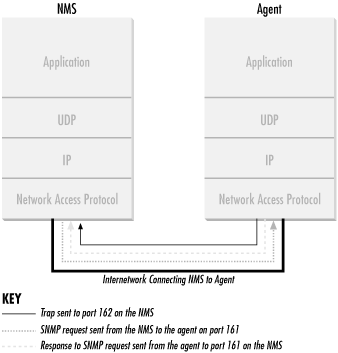
Chapter 2. A Closer Look at SNMP
Contents:
SNMP and UDPSNMP Communities
The Structure of Management Information
Extensions to the SMI in Version 2
A Closer Look at MIB-II
SNMP Operations
Host Management Revisited
Remote Monitoring Revisited
2.1. SNMP and UDP
SNMP uses the User Datagram Protocol (UDP) as the transport protocol for passing data between managers and agents. UDP, defined in RFC 768, was chosen over the Transmission Control Protocol (TCP) because it is connectionless; that is, no end-to-end connection is made between the agent and the NMS when datagrams (packets) are sent back and forth. This aspect of UDP makes it unreliable, since there is no acknowledgment of lost datagrams at the protocol level. It's up to the SNMP application to determine if datagrams are lost and retransmit them if it so desires. This is typically accomplished with a simple timeout. The NMS sends a UDP request to an agent and waits for a response. The length of time the NMS waits depends on how it's configured. If the timeout is reached and the NMS has not heard back from the agent, it assumes the packet was lost and retransmits the request. The number of times the NMS retransmits packets is also configurable.At least as far as regular information requests are concerned, the unreliable nature of UDP isn't a real problem. At worst, the management station issues a request and never receives a response. For traps, the situation is somewhat different. If an agent sends a trap and the trap never arrives, the NMS has no way of knowing that it was ever sent. The agent doesn't even know that it needs to resend the trap, because the NMS is not required to send a response back to the agent acknowledging receipt of the trap.
The upside to the unreliable nature of UDP is that it requires low overhead, so the impact on your network's performance is reduced. SNMP has been implemented over TCP, but this is more for special-case situations in which someone is developing an agent for a proprietary piece of equipment. In a heavily congested and managed network, SNMP over TCP is a bad idea. It's also worth realizing that TCP isn't magic, and that SNMP is designed for working with networks that are in trouble -- if your network never failed, you wouldn't need to monitor it. When a network is failing, a protocol that tries to get the data through but gives up if it can't is almost certainly a better design choice than a protocol that will flood the network with retransmissions in its attempt to achieve reliability.
SNMP uses the UDP port 161 for sending and receiving requests, and port 162 for receiving traps from managed devices. Every device that implements SNMP must use these port numbers as the defaults, but some vendors allow you to change the default ports in the agent's configuration. If these defaults are changed, the NMS must be made aware of the changes so it can query the device on the correct ports.
Figure 2-1 shows the TCP/IP protocol suite, which is the basis for all TCP/IP communication. Today, any device that wishes to communicate on the Internet (e.g., Windows NT systems, Unix servers, Cisco routers, etc.) must use this protocol suite. This model is often referred to as a protocol stack, since each layer uses the information from the layer directly below it and provides a service to the layer directly above it.

Figure 2-1. TCP/IP communication model and SNMP
When either an NMS or an agent wishes to perform an SNMP function (e.g., a request or trap), the following events occur in the protocol stack:
- Application
-
First, the actual SNMP application (NMS
or agent) decides what it's going to do. For example, it can
send an SNMP request to an agent, send a response to an SNMP request
(this would be sent from the agent), or send a trap to an NMS. The
application layer provides services to an end user, such as an
operator requesting status information for a port on an Ethernet
switch.
- UDP
-
The next layer, UDP, allows two hosts to
communicate with one another. The UDP header contains, among other
things, the destination port of the device to which it's
sending the request or trap. The destination port will either be 161
(query) or 162 (trap).
- IP
-
The IP layer tries to deliver the SNMP packet to its intended
destination, as specified by its IP address.
- Medium Access Control (MAC)
-
The final event that must occur for an
SNMP packet to reach its destination is for it to be handed off to
the physical network, where it can be routed to its final
destination. The MAC layer is comprised of the actual hardware and
device drivers that put your data onto a physical piece of wire, such
as an Ethernet card. The MAC layer also is responsible for receiving
packets from the physical network and sending them back up the
protocol stack so they can be processed by the application layer
(SNMP, in this case).

Copyright © 2002 O'Reilly & Associates. All rights reserved.



